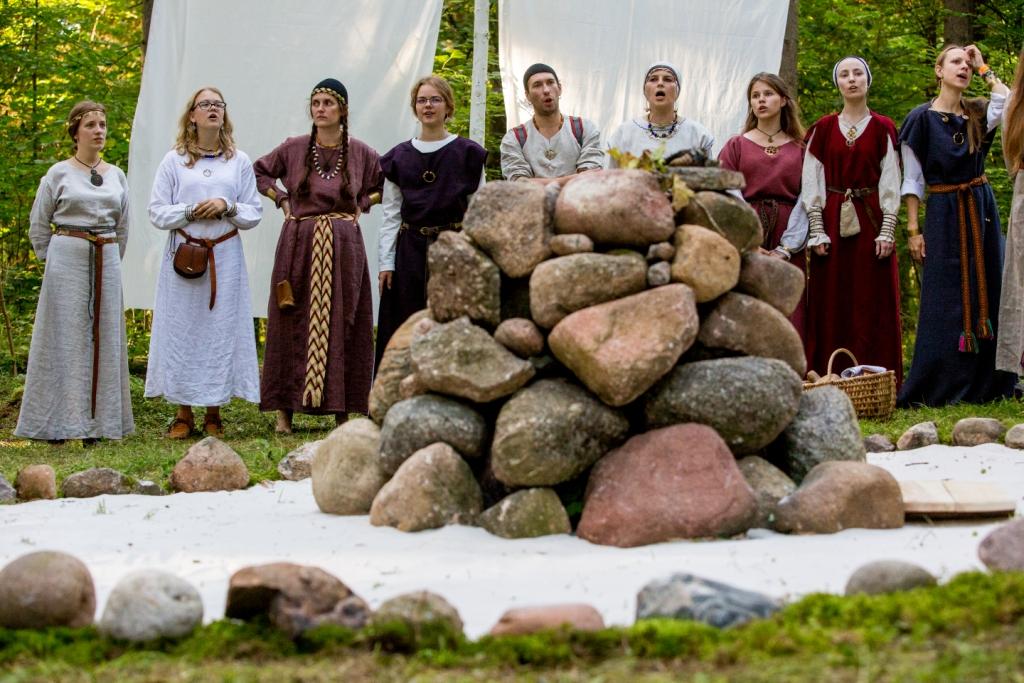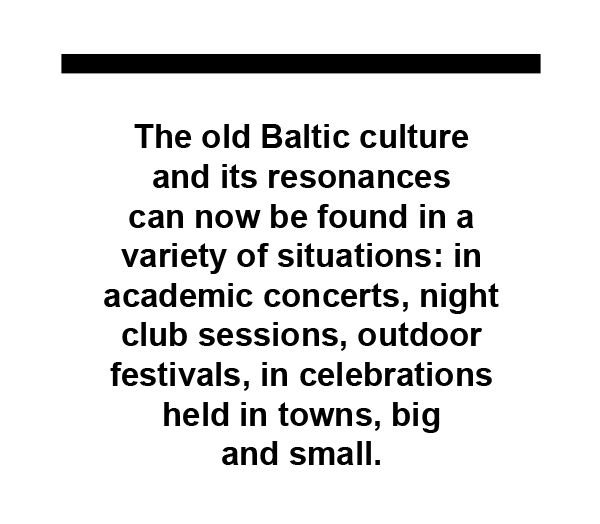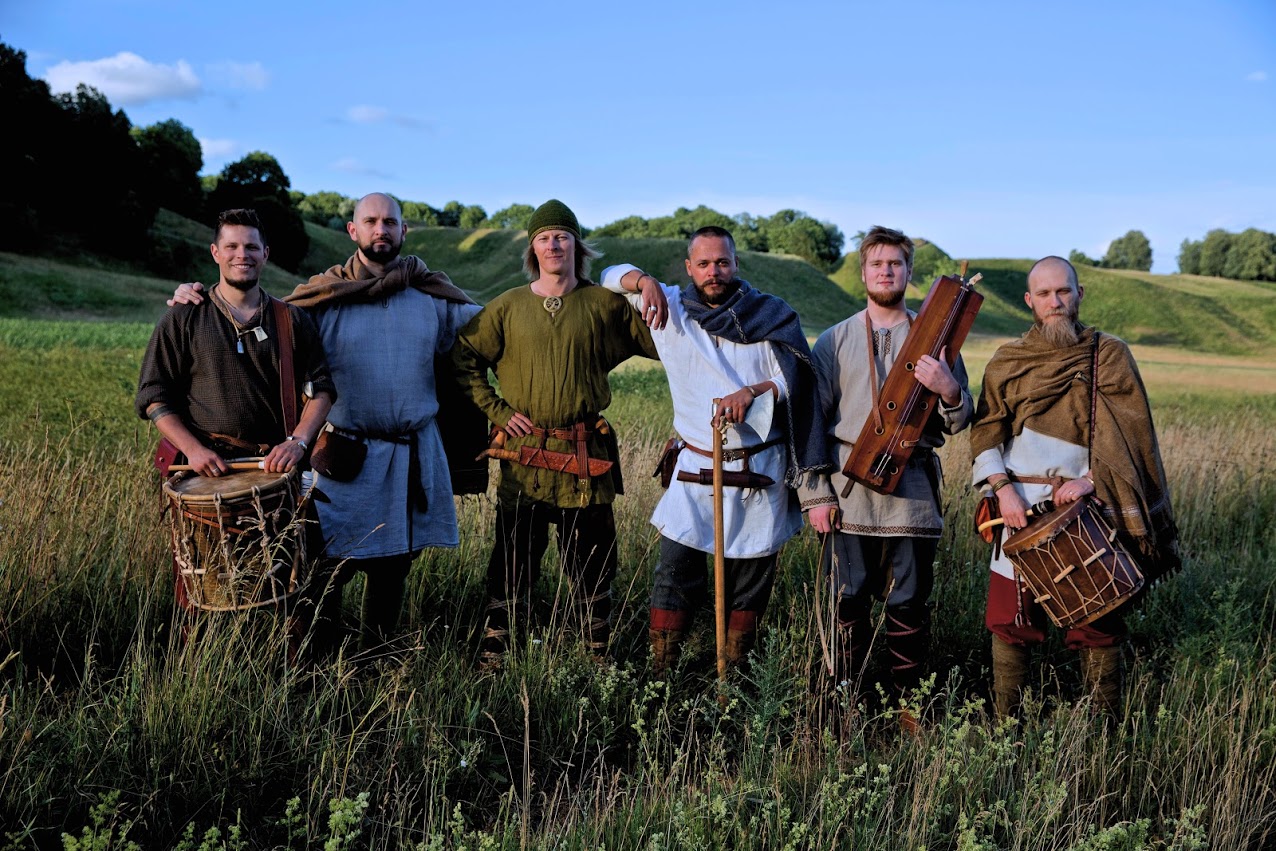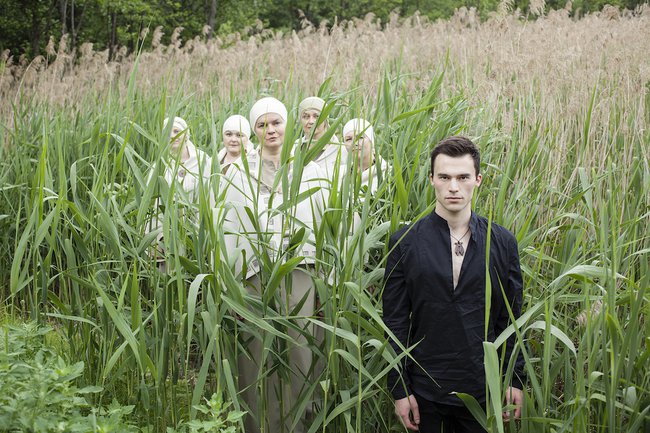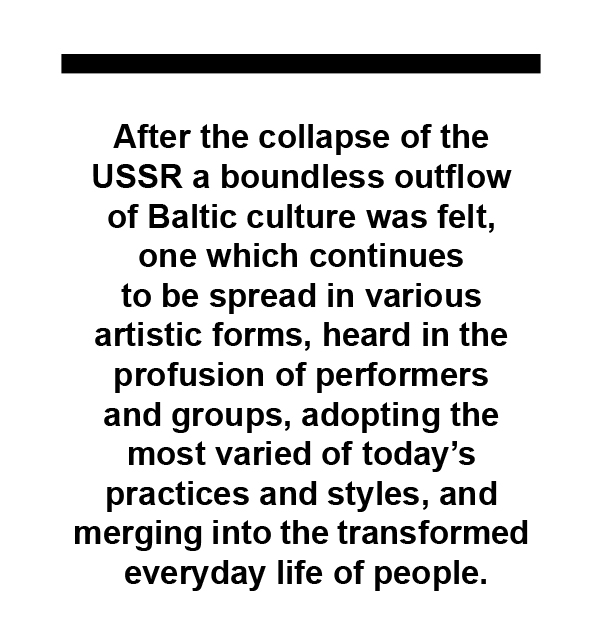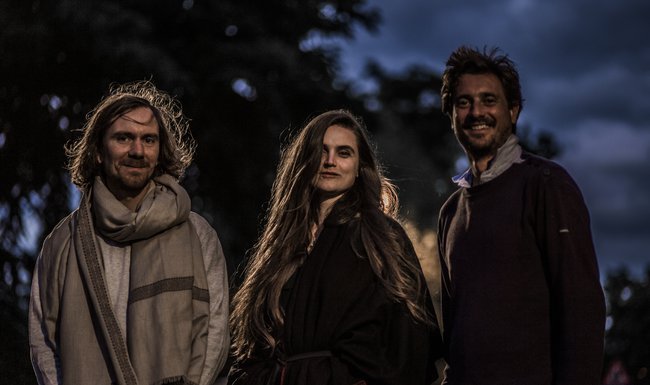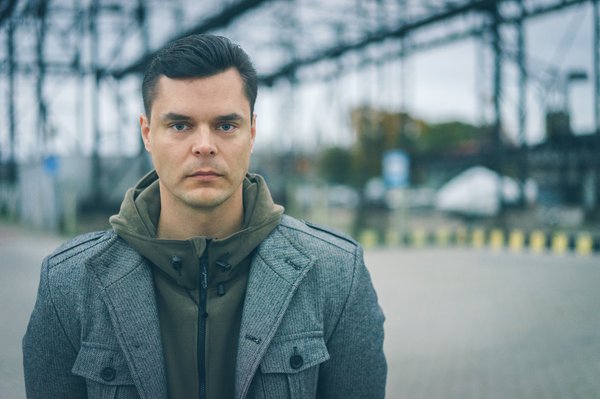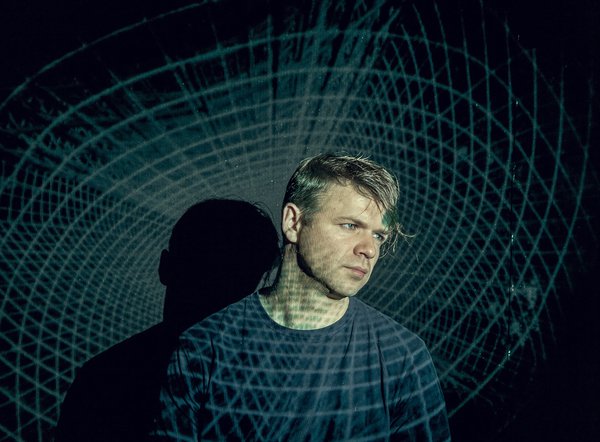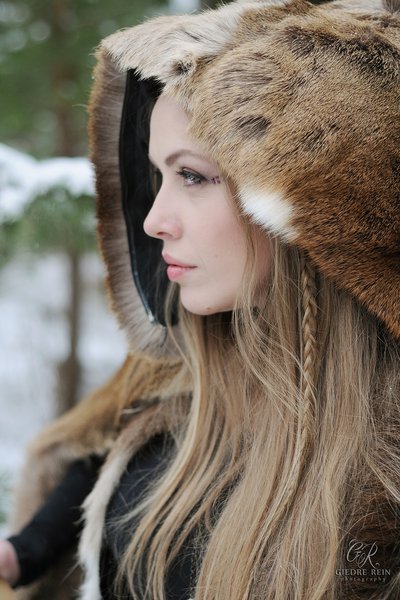Eglė GELAŽIŪTĖ-PRANEVIČIENĖ | Lithuanian Postfolklore: The Archaic Baltic Music in Modern Times
Old cultures often have to be protected and practiced consciously in order for them to survive in the form as authentic and retaining their essential components as possible. Often, however, the danger arises which a culture that is overly protected and considered inviolable can become one’s own only theoretically and, while observed from a ‘safe’ distance, will remain in museums as a distant memory. Culture has to be lived, hence, in addition to an essential conscious comprehension of one’s own culture, an evaluation of its position in today’s circumstances, a very important feeling is intuition. That which is intuitively recognised as one’s own, which allows us identify ourselves with our own culture, seeing ourselves as a part and a continuation of that culture. When being a part of whatever culture, in a certain sense we have the right to play with it through our own experiences, without artificially separating ourselves from today’s world which brings cultures together.
Before a discussion of specific performers, it is important to say that Lithuanians nowadays are increasingly identifying themselves with the archaic Baltic religion, that is, paganism or neo-paganism. Some are doing that very naturally because of feeling a connection: they join communities, take part in celebrations, engage in a new-old rhythm they yearn for. Others, opposed to Christian religious beliefs they find unacceptable, choose only certain rituals (for example, pagan weddings and name-giving ceremonies instead of a christening, etc.). Regrettably, Romuva, the oldest Baltic faith community, after this year’s deliberations in the Seimas of the Republic of Lithuania, was not recognised as an official religion with equal rights and its faith being able to be taught in schools or practiced as an alternative to Christianity.
Already at the end of the 19th century Lithuanian folklore began to be understood not only as a tradition or village culture but also as a new creative phenomenon of professional (today the term would be ‘authorial’) music. According to the ethnomusicologist Austė Nakienė, classical examples of this are the harmonised Lithuanian folk songs by Mikalojus Konstantinas Čiurlionis, Juozas Naujalis and Česlovas Sasnauskas, in which the authentic melodic lines are adhered to, while the harmonic accompaniment has been created with reference to the particular quality of their structure. Lithuanian folklore as a creative source was a feature not just of that time period but spontaneously emerged in later times and is still being expressed in contemporary professional compositions, as well as electronic, jazz and experimental music. The old Baltic culture and its resonances can now be found in a variety of situations: in academic concerts, night club sessions, outdoor festivals, in celebrations held in towns, big and small. Today postfolklore music in Lithuania is multi-faceted, a phenomenon that attracts different generations in its various forms: in its authenticity, as sound material, and as a practice of self-discovery. It is no coincidence that there is an increase in various collectives with a strong interest in the Baltic faith and culture and performers diving, as it were, into the old culture, with the aim of conveying as authentically as possible, both through completely new connections and bold sound play, as well as through sound systems of different origins extending one another. It would be difficult now, nor is it necessary, to draw a strict distinction between authentic collectives and postfolklore expression – for both the first thing that is necessary is having a feel and knowledge of authenticity. The group Ugniavijas, in which exclusively male voices can be heard, has been in existence for quite a long time resurrecting the old Lithuanian war songs, continuing the Lithuanian singing tradition with lively, strong and spacious harmonies. The instruments are not used for solos but to emphasise the power of the song. Because the members of the group are particularly interested in the old crafts, clothes and musical instruments of the Baltic tribes, all the elements naturally fit together and expand one another. By the way, Vytenis Jankauskas, one of the members, together with the folklore performer and teacher Laurita Peleniūtė regularly organise open singing sessions of the old songs with an increase in the number of participants and that marks the need for Baltic culture, its life and the natural identification of present-day Lithuanians with it. The need to be a part of a culture is fulfilled as more and more expressions of folklore emerge. Trys Keturiose, a group of female singers performing sutartinės, an exceptional Lithuanian genre, has been in existence now for more than thirty years. All the performers have a multi-faceted understanding of Lithuanian folklore stemming both from a host of folklore expeditions and their studies, as well as constant practice. With an especially strong focus on old intonations and timbers, by not only singing the sutartinės at performances but also using ritual movement in the space they occupy, they preserve and convey completely unique, old sonic experiences. When participating in a host of international festivals they share Lithuanian sounds, most often in an authentic form, but they also do not avoid joint cross-over projects with various contemporary arts, media, and musical genres. Worthy of mention are such different projects as Flux(s)utartines with the radical experimenting composer Rytis Mažulis and the British new music cellist Anton Lukoszevieze (created to a commission by Concertgebouw Brugge) or the cross-over folk/dance/electronic project Sutartinės Party, conceived by Linas Rimša and Linas Paulauskis, and successfully presented at the Berlin alternative music festival MaerzMusik. The most outstanding international project of recent years Ancestors, was created with the performer and composer Abraham Brody (who was born and raised in the USA, but has Lithuanian roots). This collaborative electronic postfolklore project has been presented in venues like the Barbican Centre in London, the John F Kennedy Center in Washington and National Sawdust in New York. It should be noted that Trys Keturiose authentically performs one of the most complicated genres of Lithuanian folklore – the sutartinės which are included in UNESCO’S Representative List of the Intangible Cultural Heritage of Humanity. These are multipart polyphonic folk songs with a special intonation and unusual vocal harmony. It is also important to note that in speaking about the sutartinės the Lithuanian term giedoti ('to chant, sing hymns’) and not dainuoti ('to sing') is used, showing not only respect for the old culture but also the ritualistic aspects of the sutartinės.Another special expression of this scene is the ritual folklore group Kūlgrinda, founded by Jonas Trinkūnas, a krivis (pagan priest) of the old Baltic faith community Romuva, and his wife Inija. With a deep knowledge and constant practice of the old rites, adapting them to the present day, Baltic wisdom is continued and transmitted, with the listener being immersed into deeply powerful soundscapes and becoming their participant. According to the group itself, its repertoire is dominated by the folklore of Eastern Lithuania, the sutartinės, the sound of kanklės, dūdmaišiai (bagpipes) and drums, sometimes varied with sound of the violin and cello. Kūlgrinda gives concerts and performs pagan wedding, baptism, funeral and other family and calendar celebration rituals according to the old Lithuanian customs.
It is good to know that such deep feelings pass from one generation to another – the compositions of the kanklės player Žemyna Trinkūnaitė, the pagan priest’s daughter, are exceptional: they are spacious and atmospheric, those atmospheres constantly being transfused with a consistent, profound flow of sounds. These compositions valued in Lithuania and beyond its borders are played on one the oldest of Baltic instruments – the kanklės (plucked string instruments belonging to the zither family). With a thorough knowledge of both folkloric and academic music, she creates original compositions basing them not only on contemporary but also old harmonies. It is interesting to note that her younger sister Vėtra (a kanklės player and singer) was chosen by the Vikings series on the History channel to perform a funeral chant in the old Norwegian language in one of the episodes.The creative work of Indrė Jurgelevičiūtė, another kanklės player, can be also be mentioned here in this connection. Both Lithuanian folklore and other music genres with Lithuanian-language texts, as well as echoes of world music can be found in it. What is important for Indrė is both a many-sided understanding of music and an improvisational approach, opening up a path to such successful international world music projects as Merope and Solo & Indrė together with the Senagalese kora player Solo Cissokho – their debut album attracted more than one million views on the YouTube platform. The completely naturally overlapping sound systems of different geographic origins appear to be very close in their inner nature and extend one another, developing into collaborative, seamless compositions, suffused with different instruments, timbres and voices.
An especially important mark of the meaning of folklore for today’s audiences is that the evening concerts or festivals of intellectual electronic music very often cannot make it without the creators of dub techno, chill-out or drone, like Vėjopatis or Girių Dvasios (often to be heard at concerts like Yaga Gathering on the chill out stage). The creative work of Saulius Spindi is new and worthwhile and in it the authentic recordings of the folk singer and informant Petras Zalanskas can be heard in the context of non-standard and carefully chosen electronic music. Exceptional and long-standing is the work of Donatas Bielkauskas, also known as Donis, in which folk music and the feeling that flows from it become a cornerstone of his music. Here one can hear various instruments being played live, experimentation with folklore, tribal, and field recordings, an extensive knowledge of instruments, rhythms, and musical stylistics, allowing Donatas to create projects that are spell-binding and of undoubtedly high artistic value, involving various other performers, encompassing both electronic and pure ambient soundscapes. Already back in 1994 he and Darius Gerulaitis created Wejdas, one of the first dark ambient projects in Lithuania, which the duo described as amber ambient, seeking to emphasise the clear connection with Baltic culture, well-known for the collection of amber along the Baltic Sea coast. All of Donis’ projects are coherent, polished and outstanding: the compositions with the above-mentioned Kūlgrinda (Hymns for the Continent, 2013) are notable for their pure, deep sound, their ritual quality, and a sense of the primordial; he often works with Rasa Serra, the well-known singer who employs a spatial manner of singing, with a Lithuanian folk song performed by her chosen by the band Enigma for their single MMX (The Social Song).Contemporary musical expression pulsing with authentic folklore and the feelings one has for one’s own culture have been consistently supported by the team at the independent publishing company Dangus, which puts out not just recordings of contemporary Baltic music of various styles but also organises the festival Mėnuo Juodaragis (The Black-horned Moon) which has no equivalent. Both the recordings and the festival encompass the most varied styles inspired by the old traditions: ritual folklore, postfolklore, electronic and experimental music. For those who are interested in Baltic culture and pagan customs, a visit to the annual festival Mėnuo Juodaragis, to the festival of live history Jotvos vartai (The Gates of Jotva, dedicated to the history of Alytus and the Yotvingian Baltic nation that lived there) or the live archaeology days at Kernavė is definitely worthwhile.
An especially important personality, connecting the Baltic world view, pagan ritual and professional music is the composer Bronius Kutavičius. His creative principle, taking on board the direction of Baltic music archaeology and pagan avant-gardism, already since the 1970s has had an enduring effect. Undoubtedly amongst the most influential of the composer’s works are the five oratorios, in which sutartinės, minimalism, rites, graphic scores, and Baltic mythology merge: Pantheistic Oratorio (1970), The Last Pagan Rites (1978), From the Yotvingian Stone (1983), The Tree of the World (1986), The Magic Circle of Sanskrit (1990). The texts for the oratorios were written by another great creative mind – the Lithuanian poet Sigitas Geda, able to recognise the primordial elements and incorporate them masterfully into the multi-layered texts.Nor are the numbers here incidental – the majority of the ensembles have been in existence for 20–30 years and mark Lithuania’s liberation from the Soviet Union. Throughout all the period of Sovietisation, which lasted almost 50 years, the Lithuanian language, culture and world view existed in various ways, often indirectly safeguarded by enlightened minds and passed on from generation to generation through folk songs and folk tales, as well as the literature suffused with them. It is very important to note that the Lithuanian world view was not just safeguarded but it itself was a safeguard, allowing people to identify themselves with their real history and nature. After the collapse of the USSR a boundless outflow of Baltic culture was felt, one which continues to be spread in various artistic forms, heard in the profusion of performers and groups, adopting the most varied of today’s practices and styles, and merging into the transformed everyday life of people. As for every nation, the culture one was born into, its conscious recognition and constant transformation are important in the process of finding and constructing oneself, in the various interconnections of commonality, turning all of that into the signs of this culture meaningful to the world.
Translated from the Lithuanian by Romas Kinka
